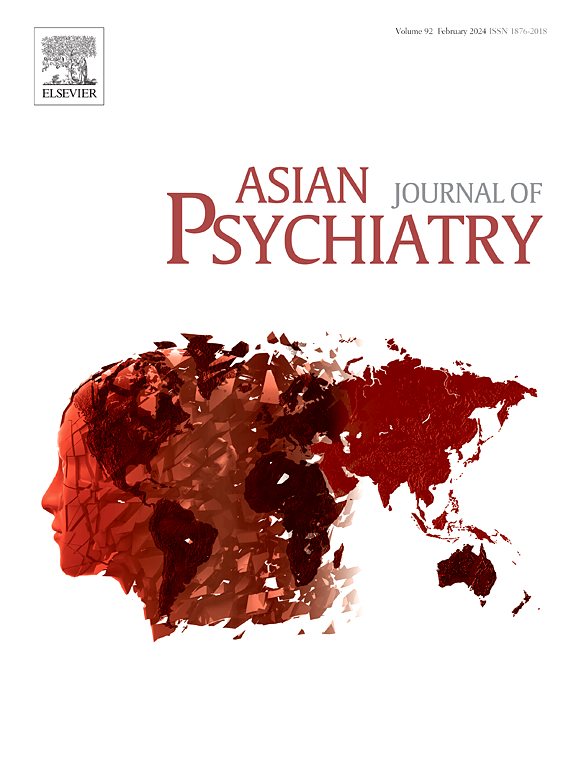Brief facial emotional recognition tool for indian population: Development and validation
IF 4.5
4区 医学
Q1 PSYCHIATRY
引用次数: 0
Abstract
Background
Facial emotion recognition is an essential component of social cognition. Due to cultural differences in emotional expression and recognition, assessment of facial emotion requires culture and ethnic specific instruments. Currently available instruments in the Indian context have limitations of copyright issues and longer version that limit their use. Hence, there is a need for brief, culturally validated tools for the Indian population.
Objective
This study aimed to develop an ecologically valid facial emotion recognition tool and validate the same among the Indian population.
Methods
The study was conducted in three phases at a tertiary care center. In Phase 1, nine mental health professionals depicted seven emotions, yielding 1636 photographs. After multiple stages of expert review and participant labeling, 130 photographs were shortlisted. In Phase 2, 33 healthy mental health professionals validated these images across two sessions, and images with over 80 % concordance were selected, resulting in a final set of 21 images. In Phase 3, the tool was administered to 45 patients with schizophrenia, 45 biological relatives, and 38 healthy controls.
Results
Patients with schizophrenia demonstrated significantly lower recognition of negative emotions (anger, disgust, fear) compared to healthy controls. Biological relatives also showed poorer recognition compared to healthy controls, particularly for anger, but no significant difference was observed between patients and their relatives. The Cronbach’s alpha value for the tool was 0.631.
Conclusion
The newly developed brief facial emotion recognition tool is a reliable, and culturally appropriate tool for facial emotion recognition in the Indian context, with potential utility in both clinical and research settings.
印度人口的简短面部情感识别工具:开发和验证
面部情绪识别是社会认知的重要组成部分。由于情绪表达和识别的文化差异,面部情绪的评估需要文化和民族特定的工具。印度现有的文书在版权问题和较长版本方面有限制,限制了它们的使用。因此,有必要为印度人提供简短的、经过文化验证的工具。目的开发一种生态有效的面部情绪识别工具,并在印度人群中进行验证。方法本研究在某三级保健中心分三个阶段进行。在第一阶段,9名心理健康专家描绘了7种情绪,产生了1636张照片。经过多个阶段的专家评审和参与者标签,130张照片入围。在第二阶段,33名健康的心理健康专业人员在两次会议中验证了这些图像,并选择了具有超过80% %一致性的图像,从而产生最终的21张图像。在第三阶段,该工具被用于45名精神分裂症患者,45名生物亲属和38名健康对照。结果精神分裂症患者对负面情绪(愤怒、厌恶、恐惧)的认知明显低于健康对照组。与健康对照组相比,亲生亲属也表现出较差的识别能力,尤其是对愤怒的识别能力,但在患者及其亲属之间没有观察到显著差异。该工具的Cronbach 's alpha值为0.631。结论新开发的简短面部情绪识别工具是一种可靠的、适合印度文化背景的面部情绪识别工具,在临床和研究环境中都有潜在的应用价值。
本文章由计算机程序翻译,如有差异,请以英文原文为准。
求助全文
约1分钟内获得全文
求助全文
来源期刊

Asian journal of psychiatry
Medicine-Psychiatry and Mental Health
CiteScore
12.70
自引率
5.30%
发文量
297
审稿时长
35 days
期刊介绍:
The Asian Journal of Psychiatry serves as a comprehensive resource for psychiatrists, mental health clinicians, neurologists, physicians, mental health students, and policymakers. Its goal is to facilitate the exchange of research findings and clinical practices between Asia and the global community. The journal focuses on psychiatric research relevant to Asia, covering preclinical, clinical, service system, and policy development topics. It also highlights the socio-cultural diversity of the region in relation to mental health.
 求助内容:
求助内容: 应助结果提醒方式:
应助结果提醒方式:


